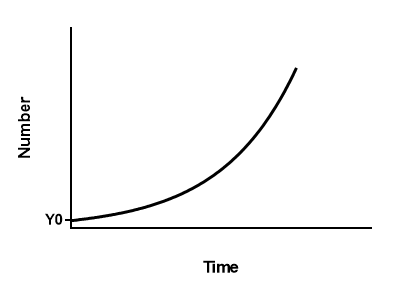This term refers to all the interacting organisms in an area along with the non-living components of the environment.
Ecosystem
Define the term "population" in ecological terms.
A group of the same species living in the same place at the same time
Define mutualism and provide an example
A symbiotic relationship in which both species benefit, examples will vary
Define primary succession and give an example of where it might occur
Colonization of a habitate that had no soil, glacier, volcanic erruption
Name the process by which plants and other organisms convert sunlight into chemical energy.
Photosynthesis
Define carrying capacity.
The max number of organisms of a single species a particular ecosystem can accomodate.
Describe the difference between predation and parasitism
Predation is a biological interaction where one organism, known as the predator, hunts, captures, and consumes another organism, known as the prey, for sustenance.
Parasitism is an ecological relationship where one organism, known as the parasite, lives on or inside another organism, known as the host, deriving nourishment and often causing harm to the host.
Describe the difference between pioneer species and climax communities
Pioneer species are the ones that move in first to an ecosystem.
Climax community is when an ecosystem is fully "developed"
Describe the difference between a food chain and a food web.
Food chain shows a linear progression of eating patterns, and a food web accounts for all feeding patterns in a community.
Give two examples of denisty dependent factors and two examples of density independent factors.
Density-Dependent Factors:
- Competition for resources such as food, water, and shelter.
- Predation and herbivory, where population density affects the rate of predation or herbivory.
- Disease and parasitism, as higher population densities can facilitate the spread of diseases and parasites.
- Territoriality, where individuals defend territories leading to density-dependent interactions.
- Intraspecific competition, which occurs within a species and can be influenced by population density.
Density-Independent Factors:
- Natural disasters such as earthquakes, hurricanes, floods, and wildfires.
- Climate factors like temperature extremes, droughts, and frost events.
- Habitat destruction or fragmentation caused by human activities like deforestation or construction.
- Pollution, including air, water, and soil pollution that can affect populations regardless of density.
- Availability of essential resources like sunlight, which can limit population growth independently of density.
What is the difference between intraspecies competition and interspecies competition?
Intraspecies is competition between two individuals of the same species
Interspecies is competition between two individuals of different species
Explain the process of secondary succession and compare it to primary succession
Secondary succession occurs in an ecosystem that has soil already established. It can happen after a natural disaster. Small plants move in first, then larger plant species are able to move in. Eventually the ecosystem reaches its climax community
List the trophic levels in order.
Producer-Primary Consumer-Secondary Consumer- Tertiary Consumer- Quaternary Consumer
Explain the difference between exponential growth and logistic growth in a population.
Exponential is r species, includes continuous growth
Logistical is k species, will eventually reach carrying capacity
Define commenalism and provide an example
A relationship in which one species benefits and the other does not benefit or is harmed
Whale Sharks and fish
How do disturbances like fires or hurricanes influence ecological succession?
Answers will vary
What percent of energy is passed from one trophic level to the next?
10%
Identify the following graph as logistical or exponential growth

Exponential
Discuss the role of a keystone species in maintaining community structure and function
Ecosystem engineer, biodiversity support, population control, stability and recilience, food web dynamics, conservation importance
What is Ms. Wade's favorite Marvel Character?
Captain America